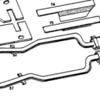Robert thanks for responding.
You didn't mention the installed height of the valve spring, but assuming the factory installed height:
1.820 installed height
-1.175 coil bind
= 0.645
-0.100 standard clearance
= 0.545 max. lift
Based on that I'd warn that you'll need different valve springs. On top of that the spring rate (347 lbs/inch) is fairly anemic for a roller cam. For a hydraulic roller cam I'd look for a spring with 150 lbs on the seat and 400 to 440 lbs/inch spring rate. The Lunati cam has a very aggressive ramp rate (indicated by 51° hydraulic intensity) for a hydraulic roller, I'm not sure 150 lbs on the seat is enough spring for that cam. If you're going to select that cam you should investigate the specs of the spring Lunati recommends, and use a spring that has at least the same specs as their recommended spring. Its always better to have too much spring than not enough.
The Aussie heads plus stock flat top pistons will yield about 8.8:1 mechanical compression. The relatively low stock mechanical compression calls for the intake valve to close as early as possible to build as much dynamic compression as possible..
Small port heads are tuned about 1000 rpm lower than the 4V heads thus we need to make sure the engine has enough intake duration to build a "street performance" powerband.
The stock exhaust system calls for a cam with long exhaust duration that opens the exhaust valve early.
The aspects which work against good drivability are too much overlap, opening the intake valve too early, narrow lobe center displacement, and opening the exhaust valve too late. I'm not enthusiastic about either of the off-the-shelf cams you've listed. If I were putting together a hydraulic roller cam for you for a reasonable street engine it would look something like this:
- Duration at 0.006 inch tappet lift = 274°/286°
- Duration at 0.050 inch tappet lift = 220°/232°
- LSA = 114°
- Seated Overlap = 52°
- ICL = 111° ATDC (indexed +3°)
- Seated EVO = 80° BBDC
- Seated IVO = 26° BTDC
- Seated IVC = 68° ABDC
That happens to be a spec I've recommended often in the past, but I didn't plan it that way. I put together each cam from scratch, this is just the way the numbers came together. You can consider it an old school cam, or something close to a production cam … but its not a hot rod cam by today's standards. The engine would run strong and do nothing wrong … guaranteed. It would run stronger with more mechanical compression. I can explain the reasoning behind the spec if necessary … just ask if you have questions.



